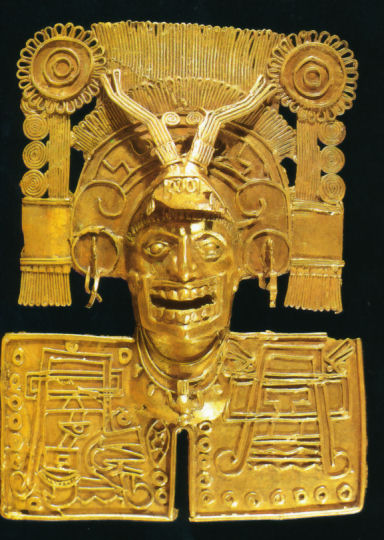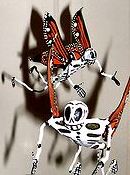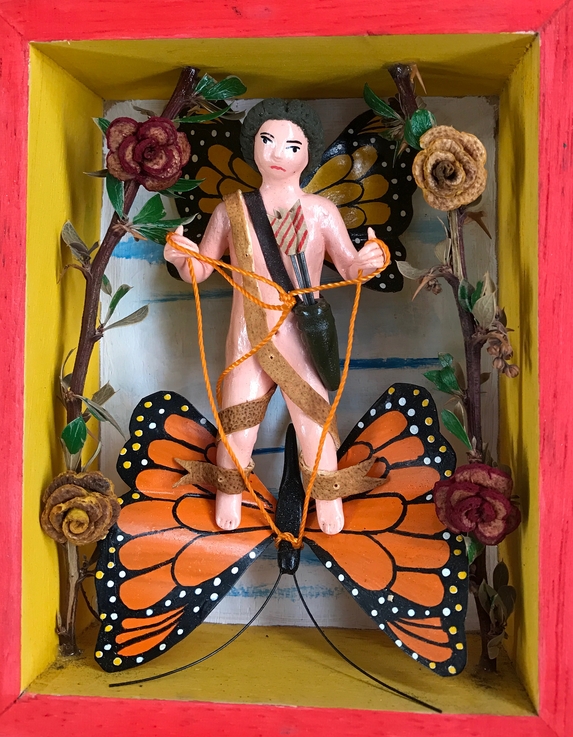| The First Place of the Dead |
|---|
|
(01) In iuh quimatïyah in nicän tläcah, in huëhuetqueh, ïhuän in tlahtohqueh: ca in ïxquichtin miquiyah, ëxcän in huih, in ihcuäc miquih. | This is what was believed by people here, the elders and the rulers: all who died went to [one of] three places when they died.
|
|
(02) In ic ceccän ömpa in mictlän. Auh in oncän Mictlän, oncän onoc, oncän cah Mictläntëuctli, … ïhuän in Mictëcahcihuätl, in ïcihuäuh Mictläntëuctli. | The first place is Mictlän or “place of the dead.” And there, in Mictlän is found, resides Mictläntëuctli, “the lord of Mictlän,” … and Mictëcah-cihuätl (“lady of the inhabitants of Mictlän”), the wife of Mictläntëuctli.
|
|
(03) Auh in ömpa huih Mictlän yehhuäntin in ïxquichtin tlälmiquih, in zan cocöliztli ic miquih in tlahtohqueh, in mäcëhualtin. | And there, to Mictlan, go all those who die a natural [= earthly] death, who die of disease, kings or commoners.
|
|
(04) Auh in ihcuäc miquiya in oquichtli, ahnozo cihuätl, ahnozo piltöntli, auh in ic quitlahtlauhtiäyah in miquiya, in momiquiliäya, quilhuiäyah, in zan oc huetztoc, in zan oc äcantoc: | And when a man would die or a woman or a little child, to speak of the one who had died, who was deceased, one would say of him that he had only “lain down,” or had only “run aground.”
|
|
[Deleted material includes words to be addressed to the dead and gifts to be offered to them.]
|
|
(36) Auh in oncän in itzehecayän, quil cencah netolïnïlo, mochi [eh]ecatoco in itztli, ïhuän in xältetl, auh ïpampa in miquiyah in oquichtin, | And in that place blow winds of obsidian, it appears that one is very miserable, that many fragments of obsidian pieces and gravel are carried by the wind, which is why, when men die,
|
|
(37) in ïntlahuizpetläcal, in ïnchïmal, in ïmmäcuauh, ïhuän in ïxquichtin ïmalteöhuän, ïhuän in ïxquich in ïtilmah, ïhuän in ïxquich in tlein ïtlahtlatqui, mochi ïpan quitlatiäyah; | their boxes of insignia, their shields, their swords, and all the [emblems of] the gods of their prisoners, all their capes, and all their property all are burned at the same time they are.
|
|
(38) zan ye nö ihui in cihuätl, in ïxquich in ïtanah, [baskets] … nö mochi ïpan tlatla: | And the same for a woman, all her baskets, [and weaving materials and adornments] … all this burns at the same time that she does.
|
|
(39) quil mach quimotenäntïz, ic mehecatzacuilïz in itzehecayän, ahmo cencah motolinïz; | It was said that [the burning] would make them a wall to protect them from the winds of the place where the obsidian winds blow, so that they would not suffer too much;
|
|
(40) auh in äquin ahtle ïtlatquitzin, in zan iuh yäuh, cencah tlaihiyöhuia, cencah motolïnia, in ic quïza itzehecayän. | and he who has no property at all, who goes all alone, he has a bad time, he suffers a great deal in passing through the place of the obsidian winds.
|
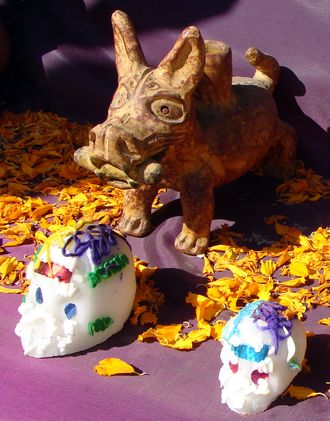
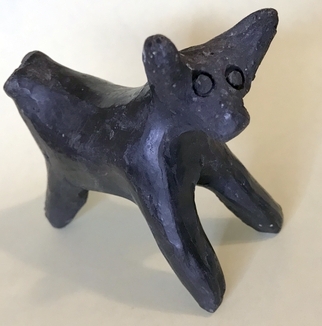 [In deleted material a little dog is used to lead the dead to their destination. The picture at right shows a dog on a modern Day-of-the-Dead altar. The tradition of a dog serving as a spirit guide is presumably the reason for the inclusion of the helpful little dog —provocatively named Dante— in the the Day-of-the-Dead-themed 2017 Pixar film Coco.
[In deleted material a little dog is used to lead the dead to their destination. The picture at right shows a dog on a modern Day-of-the-Dead altar. The tradition of a dog serving as a spirit guide is presumably the reason for the inclusion of the helpful little dog —provocatively named Dante— in the the Day-of-the-Dead-themed 2017 Pixar film Coco.
Upon arrival they present the goods they have been given to the lord of the land of the dead. The faithful guide dog is then cremated with the other goods.
The travels of the dead go on for four years, after which time they are finally released into extinction.]
|
|
(60) Ïhuän in ihcuäc miquiyah in tlahtohqueh, ïhuän in pïpiltin, quintolöltiäyah chälchihuitl; auh in zan mäcëhualtin, zan texoxoctli, ahnozo itztli, quil mach ïnyölloh mochïhua. | And when kings and nobles die, they put a piece of jade in their mouths, and for simple commoners, a green stone or a piece of obsidian; they say that this give them a heart.
|
|
[In deleted material the process of cremation is described in lurid detail, as is the burial of the bones thereafter.]
|
| The Second Place of the Dead |
|---|
|
(67) In ic öccän huïlöhua ömpa in Tlälöcän. Auh in Tlälocän cencah netlamachtïlo, cencah necuiltonölo, aïc mihiyöhuia, | The second place where people go is the Tlälocän, “the place of the rain gods.” And in Tlälocän one knows happiness and well being; one never suffers.
|
|
(69) Auh ömpa nemih in tlälöqueh, iuhqueh in tlamacazqueh, päpapahhuahqueh, iuhqueh in tlenämacaqueh catcah. | That is where the rain gods live, who are like priests, like the long-haired priests, or the fire-offering priests.
|
|
(70) Auh in ömpa huih yehhuäntin in huïtecoh, ïhuän in ilaquïloh, ïhuän in ätlan miquih, ... . | And there go those who were struck [by lightning], and those who were drowned, those who died in water, [or died of various diseases].
|
|
(72) In yehhuän in, in ihcuäc miquih, ahmo tlatlah, zan quintöcayah, … | These people, when they die, do not burn; they are simply buried; …
|
|
(74) Iuh quihtoah, in tlälöcän mochipa tlaceliya, mochipa tlatzmolïni, mochipa xöpantlah, tlaxöpammahmani. | And they say that in Tlälocän nature is always green, the buds always open; it is always spring, a perpetual spring.
|
| The Third Place of the Dead |
|---|
|
(75) In ic ëxcän huïlöhua, ömpa in ïchän tönatiuh ilhuicac: yehhuäntin ömpa huih in yäömiqui, | The third place where they go is to the domain of the sun in the sky. That is where those who die in war go,
|
|
(76) in ahnozo huel oncän niman miquih yäöc, … in ahnozo zan calaquïloh, in zätëpan miquizqueh: | as well as those who die in full combat, … those who are captured to die later,
|
|
(77) in ahzo huahuanoh, ahzo tlepan tläxoh, ahzo tlaxichhuiloh, ahzo teöcönhuïloh, … mochintin huih in tönatiuh ïchän. | those who have been flayed, thrown into fire, pierced with spears, spines, … they all go to the home of the sun.
|
|
[In deleted material the fiercer warriors are described as having greater privileges than the lesser ones.]
|
|
(81) Auh in ihcuäc önäuhxiuhtiqueh, niman ic mocuepah tlazohtötömeh, huïtzitziltin, xöchitötötl, tötöcoztli … tïzapapalötl, ihhuipapalötl, … : tlachïchïnah in ömpa ïmonoyän. | And at the end of four years, they are transformed into rare birds: hummingbirds, orioles, yellow birds … white butterflies, downy butterflies, …: they gather nectar wherever they dwell.
|

 [In deleted material a little dog is used to lead the dead to their destination. The picture at right shows a dog on a modern Day-of-the-Dead altar. The tradition of a dog serving as a spirit guide is presumably the reason for the inclusion of the helpful little dog —provocatively named Dante— in the the Day-of-the-Dead-themed 2017 Pixar film Coco.
[In deleted material a little dog is used to lead the dead to their destination. The picture at right shows a dog on a modern Day-of-the-Dead altar. The tradition of a dog serving as a spirit guide is presumably the reason for the inclusion of the helpful little dog —provocatively named Dante— in the the Day-of-the-Dead-themed 2017 Pixar film Coco. 